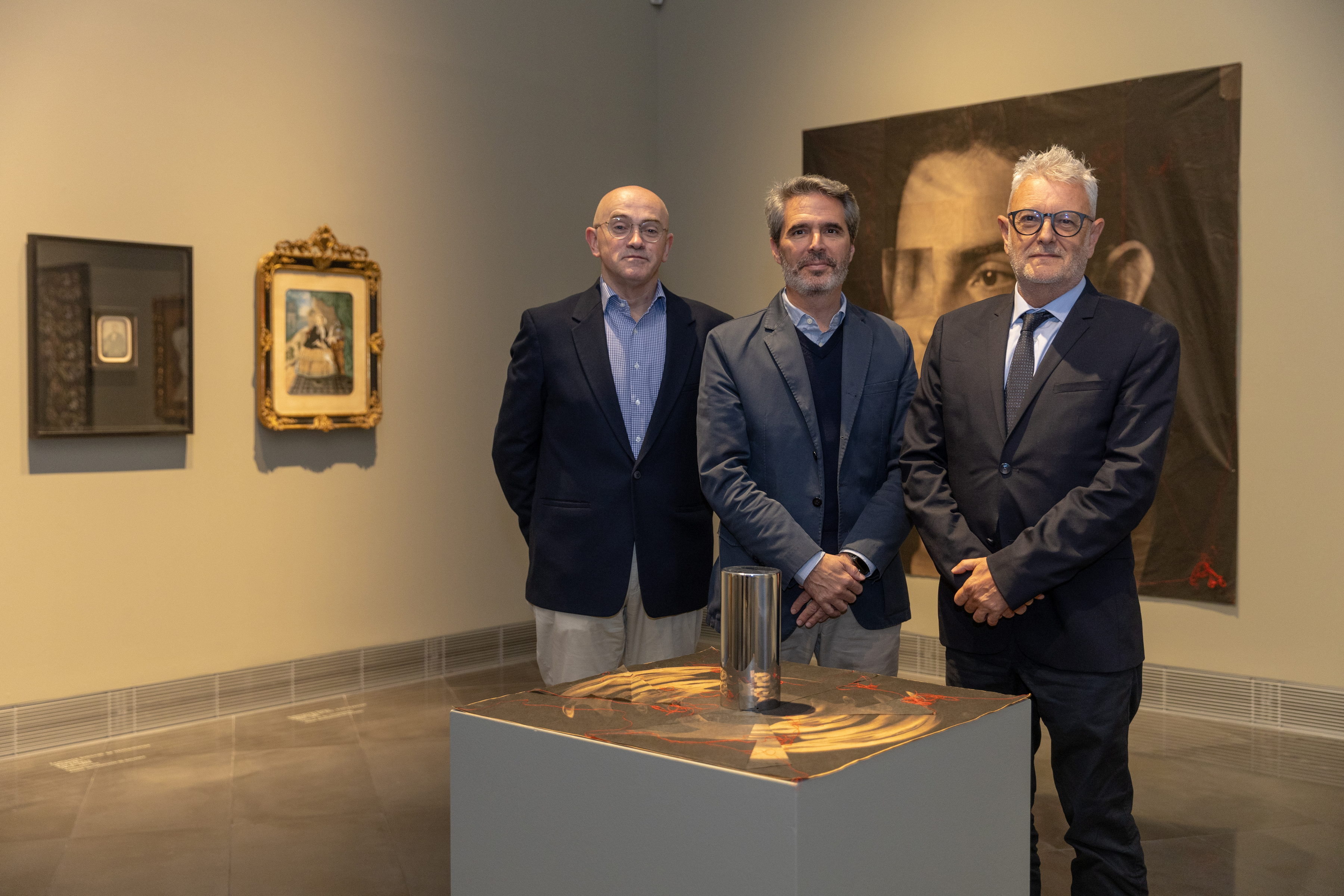A journey from daguerreotype to artificial intelligence in the first exhibition of the MUN collection
The Museo Universidad de Navarra opens the first major exhibition of its Collection, which presents more than a thousand pieces of photography, painting, sculpture and video installation.

FotoManuelCastells/MUN general director, Jaime García del Barrio, with the curators of the exhibition, Valentín Vallhonrat (right) and Ignacio Miguéliz (left).
On the eve of its tenth anniversary, the MUN fills its entire exhibition space with the most emblematic works of its Collection and proposes a journey through its history and, with it, an exciting journey through 185 years of art.
Collection Museo Universidad de Navarra. Four decades is the title of the exhibition that opens today, Tuesday, September 24. At 7 p.m. there will be a masterclass open to the public with the curators of the exhibition, Valentín Vallhonrat and Ignacio Miguéliz, who will provide the viewer with the keys to this extensive itinerary. Admission is free, with prior withdrawal of an invitation at the box office or on the website. The exhibition, consisting of more than a thousand titles, can be visited during the whole academic year, until next August.
The general director of the MUN, Jaime García del Barrio, and the curators of the exhibition presented the proposal to the media this morning. This exhibition, said García del Barrio, is "the launching of the Collection, with all the lines of work and research it generates". It presents "a deep and clear discourse at the same time," he added.
The MUN Collection began in 1981 with the donation made by photographer José Ortiz Echagüe to the University of Navarra. Almost three decades later, in 2008, the Navarre collector María Josefa Huarte donated her contemporary art collection, under the premise of opening a museum to house it.
But the collection has been expanding over the course of forty years, drawing from all artistic disciplines, with new holdings, donations, newly created works and some acquisitions. In the 1990s, the University of Navarra contacted artists, photographers and cultural managers Rafael Levenfeld (+) and Valentín Vallhonrat. They devised a collection project that would allow us to delve into the evolution of the visual arts in the construction of images that allow us to understand and interpret reality, as well as an analysis of photography as a document and also as an artistic expression. Today, forty years later, we can affirm that the MUN treasures and displays a unique collection of photography, with works by national and international artists produced in Spain, from the origin of the photographic technique to the present day.
"The first intention we had was to form a photography collection in Spain because it didn't exist", unlike in other countries, Vallhonrat recalled. Subsequently, "each piece that has entered the Collection has done so for a reason: it is related to other pieces" and, in addition, it allows access "to a rich vital experience", linked to "freedom, related to knowledge", he explained in reference to "the function of art to offer us spaces that we do not reach, and that are ours".
This exhibition has a triple objective, which coincides with that of the collector María Josefa Huarte, said Ignacio Miguéliz: "Contemporary art is not understood and rejected, and she wanted it to enter people's lives, to be explained and, as a result of that understanding, they can accept or reject it". She also alluded to research and dissemination and, thirdly, to conservation, in order to bequeath this collection "to the future".
The curator also explained the structure of the exhibition. Collection Museo Universidad de Navarra. Four decades starts with "Multiple origins in a collection. The María Josefa Huarte Collection and the creation of the Museum", which presents the donation of the Navarre collector, consisting of 47 pieces by 18 different artists from the second half of the twentieth century and early twenty-first century, including international names of the stature of Kandinsky.
After the inauguration of the Museum -in January 2015-, works from acquisitions, deposits and donations have been added; both painting and sculpture, as well as photography, video and installations. Visitors will find them distributed in four rooms: Figuration (Sorolla, Picasso, Cecilia Paredes...), the Wall as a space for creation (Tàpies, Oteiza or Brazuelo), Informalist Abstraction (Rothko, Maselli) and Geometric Abstraction (Palazuelo, Chillida, Sempere, Elena Asins).
The visit will continue with "Multiple beginnings for multiple visions": the Ortiz Echagüe collection, the techniques of daguerreotype and calotype, or the works resulting from the artistic residency program, which allows contemporary authors to dialogue with the Collection. Tender puenteswhich allows contemporary artists to dialogue with the Collection. Joan Fontcuberta inaugurated this project, and he himself was the author of the first proposal elaborated with Artificial Intelligence at the MUN. It continues with the arrival of audiovisual formats to the Collection, initiated with the Navarrese artist Carlos Irijalba and his piece Inertia. This was followed by video installations (Daniel Canogar, Sikka ingentium). In addition, two other new areas of development in the MUN Collection are the photographic collections of Latin America and the Middle East.
The exhibition concludes with "From the 19th to the 21st century. A journey through four decades": starting with the techniques of wet collodion and albumen paper, continuing with pictorialism and the avant-garde in Spanish photography, and continuing with the social documentary photography of the first third of the 20th century. Then, names such as Pierre Gonnord, Bleda y Rosa, Manolo Laguillo or Roland Fischer appear, as well as documentary, propagandistic, advertising and photojournalistic photography of the Civil War, the evolution of the discipline in the second half of the 20th century, and the union of the arts and the appearance of new formats in our century.